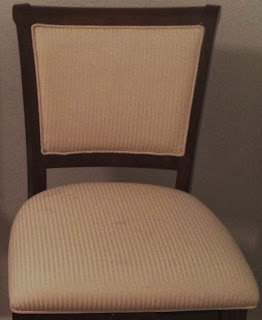The problem, and this was something I didn't notice in the photos, was that though there were four bar stools,
each pair was completely different from the other. Looking at the photo
now, I'm completely embarrassed that I was oblivious to the difference.
How
does that brief explanation relate to painting upholstery? I'm getting
to that. The two bar stools on the left and the right in the photo were
easy. It was simply a matter of unscrewing the cushion, reupholstering,
and screwing them back on. Then there were the two in the foreground and
background. Here is a crappy close-up of my dilemma.
I
was all set to reupholster these stools in the same way. The seat
cushion easily unscrewed, and the back cushion.......the back cushion. I
remember thinking, "What in the hell am I going to do with the back
cushion?" There were no screws to unscrew. It would not push or pull
out. Lovely.
Something had to be done because there were numerous unsightly stains.
The seat cushions were the same as the others, so I was thinking that I
would just reupholster the stools like i had the other two. Then I
realized the backs did not screw in. I considered cutting them out, but
piping around upholstery is above my pay grade. Then I wondered, "Could
the fabric be painted?" After a bit of research, I learned that it could
indeed be done. Here is the procedure:
Step 1:
Clean the fabric to be painted, and clean it well. Use a lint brush.
You want all dust, debris, and in my case, cat hair off the fabric.
Step
2: Mix the latex paint and the fabric medium. If you don't know what
fabric medium is (I didn't), here is a photo. It does a great job of
keeping the fabric from getting too hard.
Use
a small plastic cup you can throw away after the project. The ratio
should be 1:1. Dilute the paint/medium mixture with water, using about
one-half the amount as the paint and medium (ratio of paint/fabric
medium/water should be 1 : 1 : 0.5). Stir the mixture.
Step 3:
Fill a spray bottle with water. Liberally spray (using a fine mist
setting on the spray bottle) the fabric you intend to paint. You want it
damp, but not wet.
Step 4: Brush on the paint,
and you will want to paint two coats. Each coat should be rather thin,
and please let the first coat dry completely before applying the second.
That, sometimes, is a difficult request if you are impatient like I am.
Step 5:
Apply the final coat. For this, you will need acrylic paint and some of
that fabric medium from earlier. You can buy the acrylic paint at any
craft store or Wal-Mart. Mix 1 part acrylic paint with 1 part fabric
medium. Dilute the mixture with a little bit of water (perhaps a water
bottle cap's worth of water). Generously paint the fabric.
Tip:
Buy the acrylic paint first. Take the acrylic paint to Lowe's or Home
Depot, and have them match the color for your latex paint.
Your final product should look something like this:
In the end, the work was
worth it. I paid $80 for the pub table and the four bar stools. I sold the painted upholstery stools for $180. I converted the drab pub table into a wine label pub table (
http://coffeeandvalium.blogspot.com/2013/12/how-to-easily-remove-wine-labels-from.html) and sold it, along with the two other stools for $250.



















